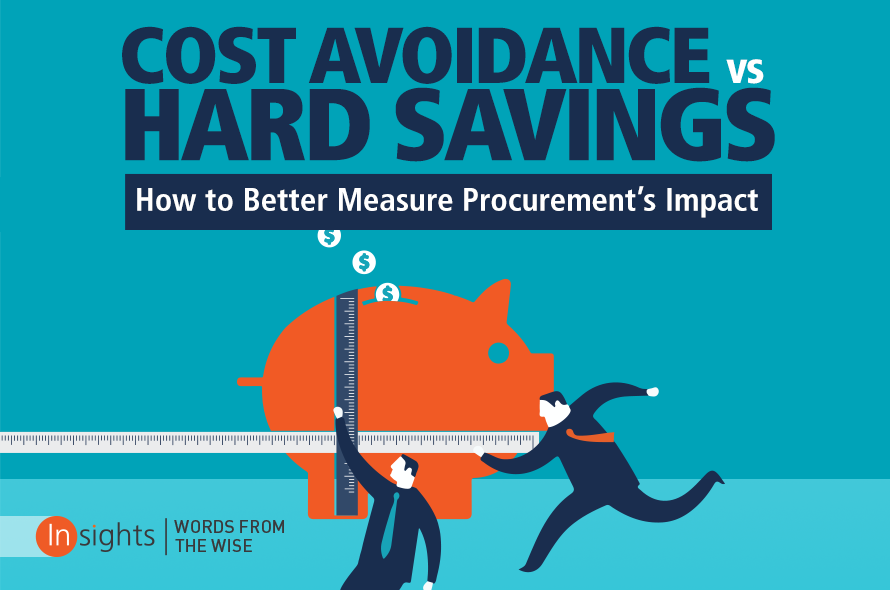The number one procurement metric is cost savings. We frequently hear that this is the only metric every CFO cares about.
In procurement, “hard saving” is generally defined as “a reduction from prior year spend for the same or similar item that is included in normal ongoing expenses.” Many procurement organizations very narrowly define hard-dollar savings to avoid the risk of overstating their measurable P&L contribution to the organization. These narrow definitions rarely include savings achieved on capital projects or from the adoption of new technologies. Savings on goods or services where a clear prior year equivalent cannot be reasonably identified for the purposes of cost comparison are also often excluded.
In general, hard savings are calculated by multiplying the difference in current prices (reduced through sourcing and negotiation) and the prior year prices times the quantity purchased. Additionally, only the first year of savings is typically counted, even if a multi-year contract is negotiated.
Organizations may make the mistake of classifying hard-to-quantify savings as an “avoidance” or “soft savings” thereby reducing their importance. Soft savings may include negotiated reductions from budgeted price, negotiated reduction below midpoint bid (or sometimes from original bid or from low bid — there is a lot of inconsistency in practice), savings from demand management, or all sorts of other things.
The logic for calculating only hard savings, is that there is a greater degree of confidence that a precise amount has been saved (because both quantity and prior year’s price are known with certainty). Cost avoidance, on the other hand, requires an estimated value that is “potentially” or “probably” saved, but similar to the location of a quantum particle, cannot be known with certainty.
That’s all well and good, and a healthy degree of conservatism in reporting is commendable. There are, however, several reasons to implement a change in savings reporting methodology:
- Hard savings impact on the future of the business may be significantly less than the impact of benefits that are classified as “soft” savings.
- Soft savings are no less real, they are simply more difficult to measure precisely, and therefore rely on some form of estimating methodology.
- Hard savings tend to exclude any areas of spend that are truly strategic as strategic purchases tend to be related to a new capability or technology, and therefore unique and different from past purchases.
- Hard savings methodology is a barrier to more strategic behavior in procurement as replacing a purchased good or service with anything too dissimilar (e.g. replacing pencils and paper with a dictation application) may not qualify as a procurement hard savings. (Although someone in another department may get credit for an “innovation” cost savings for the same project.)
- Hard savings do not include most upstream or downstream benefits (such as improved productivity) from purchasing something of improved quality or effectiveness other than those benefits that can be included in total cost of ownership.
- Hard savings do not include the value of acquiring an improved feature or function that is valuable and will be put to use in the company’s business.
- Hard savings do not comprehend the value of potential regulatory penalties and other risk costs avoided through improving transparency, compliance and other controls.
If procurement is to have a transformational impact on the company, it must measure its actions related to strategic initiatives with equal importance to its effort to reduce steady-state spend. Even the most cautious CFO recognizes that soft savings are as important as hard savings (if not more), but may be concerned that the procurement organization doesn’t have the skill set to bring sufficient financial rigor to a credible calculation of savings methodology. This becomes obvious when one considers that a CFO will readily accept cost savings coming from other areas of the company that include savings from automation, process redesign, outsourcing and a wide variety of other project types.
Procurement holds itself to a simpler standard, but is it the right standard simplified for the right reasons? A procurement view of savings, in some ways, is a vestigial behavior from a time before strategic sourcing, when procurement’s impact was measured primarily by aggressive negotiation to drive price concession.
Procurement savings calculations do not generally correlate to Generally Accepted Accounting Principles (GAAP), or standard Financial Planning and Analysis (FP&A) models. Thus, hard savings calculation by procurement is a unique throwback to a time when straight savings were considered the only value contribution, in a time where value is now typically driven by collaboration, and savings and performance credit is shared across the project rather than attributed to a single function.
The value of procurement done well is to drive external spend in a way that creates optimum value for the company for each cent that the company spends. Spending less money on the wrong things is no better than spending too much money on the right things, or buying the right things in a way that does not capture their full value. Procurement’s current measurement system, with its focus on hard cost savings, often can put it out of alignment with other parts of the business.
An overemphasis on hard savings as a proxy to demonstrate a P&L impact is an opportunity lost. If procurement adopts the same financial models and business case models used elsewhere in the corporation, it will more completely report the contribution of the projects on which procurement is involved to the overall benefit of the company, measured in both profits and losses.
By doing so, the entire organization profits from a procurement culture that will better align its behaviors and incentives to drive more strategic transformation, and better assess the benefits and costs associated with different alternatives in more complex sourcing decisions.
About the Author:
Bill Huber, Managing Director with Alsbridge, held high-profile positions in procurement leadership at several major U.S. companies prior to his ongoing success on the consulting and advisory side of the business. Bill is a recognized thought leader and sought-after speaker at major industry events.

